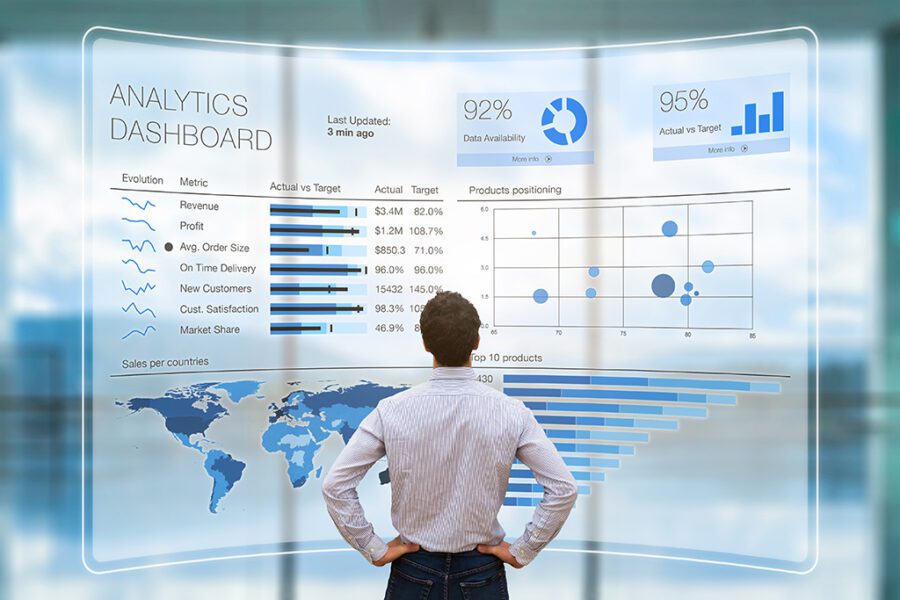Data is a resource that has become an essential part of the business world. It can be used to determine the fate of a business. Power BI, Microsoft Fabric and other tools that are powerful can be used by companies to realize the full potential of their data. These platforms form the basis of business intelligence, and when combined with Azure Data Factory, they transform into a formidable force in data analysis and decision-making.
Power BI: Your Business Intelligence Companion
Power BI by Microsoft is an extremely powerful software for business intelligence that lets organizations visualize and share their data. It empowers users to create interactive dashboards and reports and transforms raw data into actionable insights.

Whether you’re a small startup or a big enterprise, Power BI adapts to the needs of your business. It seamlessly integrates with different sources of data and makes it easy to merge data from several platforms and databases. With its simple drag-and-drop interface even non-technical users can quickly produce insightful reports and analyzes.
Power BI supports real-time processing of data, which ensures that you are always armed with the most current data. The platform offers a variety of visualizations, allowing users to present data in an easy-to-read, engaging manner. It is essential to be able to share and collaborate on reports. This can help in improving decision-making within your company and encourage a data-driven environment.
Microsoft Fabric Weaving Data Innovation
Microsoft Fabric is the core framework that connects and orchestrates data across various Microsoft services. Fabric weaves data into a cohesive entity that is used by businesses.
Microsoft Fabric helps businesses maintain the integrity of their data as they manage increasing data volumes. Microsoft Fabric is integrated with a wide range of services ranging from Azure Data Lake Storage, Azure SQL Data Warehouse, and Power BI. This connectivity ensures that information flows smoothly and that insights can be drawn from multiple sources.
Microsoft Fabric’s data transformation capabilities provide a wonderful illustration of its flexibility. You can utilize it to collect data, clean and make it ready for analysis and ensure it adheres to your organization’s data governance policies. Microsoft Fabric is the framework used to ensure that your data is accurate and reliable for analytics.
Azure Data Factory – The Gateway to Data Transformation
Azure Data Factory is another essential component in the modern business intelligence landscape. The cloud-based service lets you to manage and plan data-driven processes. Azure Data Factory provides meaningful insight through the orchestration of the movement of data and its transformation.
Azure Data Factory’s ability to connecting to different sources of data is one of its primary strengths. No matter if your data is located on-premises or in the cloud it is able to be seamlessly integrated, ensuring you have an all-encompassing view of your entire data ecosystem. The platform can handle batches of processing, real-time data streams and big data analytics. This makes it suitable for many scenarios.
Azure Data Factory has a visual user interface that makes it easier for the process of creating data pipelines. Even if you’re not a programmer it is easy to design the schedule, monitor and control of data pipelines. This software lets businesses regulate their data integration process and allows them to prepare data by themselves.
Power BI with Microsoft Fabric, Azure Data Factory, and Power BI
When Power BI and Azure Data Factory is combined together, they create powerful three-in-one that will transform your data analysis processes. What is their relationship?
1. Data Integration: Azure Data Factory is able to connect with many data sources. This makes sure that all data you have is accessible. Microsoft Fabric orchestrates the data from various services by using this data integration function. It ensures that your data are properly organized, cleaned and ready for analysis in Power BI.
2. Microsoft Fabric’s Data Transformation feature is vital to satisfy your analytical needs. The fabric is a powerful instrument for data transformation as well as data cleansing and wrangling.
3. Power BI will take over after your data is refined and is ready. It allows you to create visually appealing dashboards and reports which make complicated data easier to comprehend. These insights can be shared with your team members to help them make data-driven choices.
4. Scalability: Azure Data Factory scales effortlessly to handle increasing volume of data, and the combined power of Power BI and Microsoft Fabric guarantees that your data is steady and reliable when your business grows.
5. Real-time Insights: Using real-time data processing capabilities, Power BI and Azure Data Factory provide real-time information that are vital to make quick and informed decisions.
Conclusion
To stay competitive in the business intelligence world businesses must utilize data efficiently. Power BI combined with Microsoft Fabric and Azure Data Factory can take your business analytics to the next level. The three tools will help you achieve amazing visualizations, improve data consistency and streamline processes. Utilize the power of business intelligence and unleash the full potential of your data.
Leave a Reply